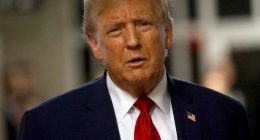
To mark the Motion Picture Association’s centenary on May 30, Adrian Wootton, CEO of the British Film Commission and Film London, has penned an exclusive op-ed for The Hollywood Reporter looking back at the unique relationship that the U.K. and Hollywood have enjoyed over the last 100 years, including the rise of British talent in the U.S., such as Charlie Chaplin and Alfred Hitchcock, the studio’s ever-lasting impact on the U.K.’s emerging industry, how the foundations were laid for franchises, such as James Bond and Harry Potter, and what the future holds.
There are often references to the “special relationship” between Britain and the USA. To me, the cultural medium that best manifests this is film and TV. Perhaps the clearest demonstration is the recent, unprecedented explosion of content-making on our shores, fueled by inward investment partners in the US studios and streamers.
Since the dawn of the “dream factory,” before and post-WWI, our production, distribution and exhibition sectors, and the talent, have been inextricably linked. Perhaps the first real global film superstar was Charlie Chaplin, a Brit who cut his teeth in British variety theater, but whose movie talent was bankrolled by burgeoning U.S. film companies and their Wall Street investors. Whilst British cinema had its own specific development, U.S. films remained hugely popular then and into the sound era, and U.S. distribution companies had large operations early on in this crucial market.
As the sound era arrived, changes to U.K. legislation were made to give more market space for British-made films. This meant U.S. studios also had to invest in “local” production. And so emerged the often-derided “Quota Quickie.” These were cheaply made “B” features funded by U.S. studios that formed part of cinemas’ supporting programs. Nonetheless, they produced some surprisingly good efforts and a who’s who of great technicians and filmmakers (like legendary director Michael Powell) made their start there. Arguably, they provided a unique training ground that became the bedrock of the subsequent Golden Age of British Cinema.
Also during this period, U.S. film companies invested in British cinema by doing distribution deals outside the U.K. for domestic producers such as Alexander Korda. They invested in studio facilities, such as Denham, where the first European Technicolour film, funded by 20th Century Fox, Wings of the Morning was shot in 1937. MGM even set up a British division, making films (including the classic Goodbye Mr Chips).
During the war, talent became the major currency of exchange. From Hitchcock to Olivier, Grant, Flynn and Leigh, many of our greatest directors, writers and performers graced some of Hollywood’s finest films. And post-war, magnificent filmmaking on both sides of the Atlantic emerged. This included the height of British production achievement from Gainsborough, Ealing and Rank, along with significant, if occasional, classic movies that represented real two-way collaboration.
Back to Korda, the legendary producer accessed U.S. talent and finance courtesy of David O. Selznick for 1949’s The Third Man, with its studio scenes shot in the U.K. In 1950, Fox funded Jules Dassin’s noir thriller Night and the City in London’s still bomb-damaged streets with the mesmerizing U.S. star Richard Widmark. The next year saw Britain’s Romulus Films co-produce John Huston’s classic The African Queen with studio scenes shot in the U.K. Meanwhile, David Lean had also started on his succession of international epics, with Bridge on the River Kwai and Lawrence of Arabia both funded by Columbia. Indeed, in the 1960s the creative and commercial interests of British cinema and Hollywood aligned. United Artists funded the low- budget(!) debut James Bond in Dr No, establishing one of movie history’s longest running franchises. Every subsequent installment has been produced and at least partially shot here, utilizing a huge array of British talent.
The U.S. film industry caught onto the zeitgeist of social change in “swinging sixties” Britain, funding distinctly British talent, producers and directors to make definitively British subject matter for international audiences, from Tom Jones in 1962 through to The Ipcress File, Alfie, and many others. Combine this with the permanent relocation of U.S. genius director Stanley Kubrick to Britain to make his movies funded by Warner Brothers — from Dr Strangelove in 1961 onwards — only on these shores (creating the production foundations that would be utilized by Harry Potter decades later) and Hollywood England was truly underway. This boom period brought many benefits to the British industry, undoubtedly leaving deep roots in talent, skills and infrastructure.
For primarily economic reasons, this ended in the early 1970s and a wilderness period began. Still, there were some seminal U.S.-financed features made in British studios during this time, including the first cycle of George Lucas’s Star Wars movies at Elstree, intermittent Kubrick epics (right through to Eyes Wide Shut) and projects like the Ridley Scott-helmed classic Alien.
This significant, but inconsistent, pattern continued until, following successful industry lobbying, successive U.K. governments introduced the fiscal incentive models in the 1990s, which would eventually develop into the tax credit support structure that has since acted as a solid foundation to protect indigenous British cinema and simultaneously stimulated inward investment in a way not seen since the 1960s.
This was a catalyst to encourage Warner Bros. to base the Harry Potter films here and build their permanent base at Leavesden. It has seen Disney, Paramount and Universal (also through its ownership of the brilliant Working Title) make numerous large-scale productions here. This situation was further stimulated by the large-scale increase in High-end TV (HETV), attracted by the expanded infrastructure, talent development and the additional tax credit.
Add to this the market entrance of the streamers, and production in U.K. nations and regions has quickly developed an enviable global position. In 2022, despite the pandemic and related obstacles, demand is rising. As an industry, we continue to meet the challenges, with more infrastructure — specifically studio space — and increasing efforts to train people to fill the thousands of extra jobs. Of course, there are the perennial concerns about the ongoing state of independent British cinema, IP development, sustainability, diversity and cultural identity.
Still, if you look at the value of the investment (content and bricks and mortar) our partners bring into the whole of the U.K. though the seven U.K. production clusters, helping us to level up before the phrase was invented, and the sheer quality of what is being made (Downtown Abbey, The Crown, Fantastic Beasts, Slow Horses, Bridgerton, Ted Lasso, to name a few), it’s clear this aspect of the special relationship is strong, healthy – and still growing.
Source: Hollywood





